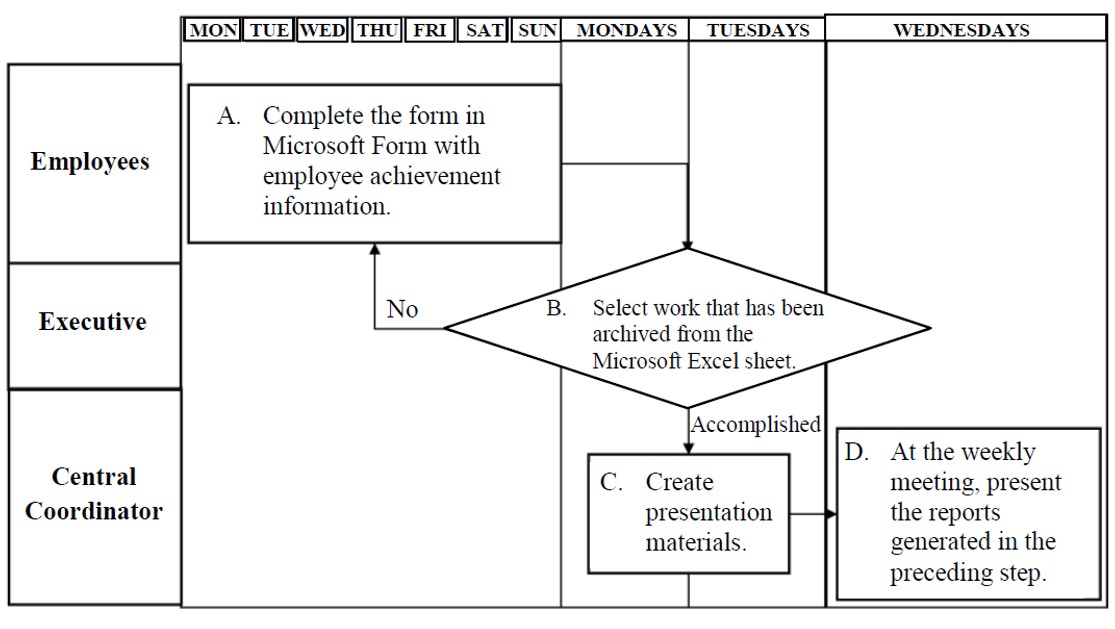Cultivating efficiency in human resource management: The integration of Lean concept and IT solutions for operational enhancement
Main Article Content
Abstract
Improving HRM operations, especially in large enterprises, requires efficient monitoring of issues and documenting individual accomplishments. This study aims to enhance these processes by integrating Lean principles with IT solutions to address inefficiencies, particularly in task recording and achievement tracking, thus advancing real-time data interconnectivity objectives. The study begins with an examination of existing operations, proceeds to analyze the process, and identifies waste while determining the value of activities. Solutions are then proposed using the ECRS technique to improve operational effectiveness. The ECRS technique for lean implementation involves utilizing ‘eliminate’ for non-value-added (NVA) activities, and ‘combine’, ‘rearrange’, and ‘simplify’ for value-added (VA) and necessary but non-value-added (NNVA) activities. After implementing these strategies using Microsoft Planner and Microsoft Power Apps, the time needed for monitoring critical issues is reduced from five days to two per week, along with streamlining the process from seven steps to five. The new application offers updates in real-time and enables staff to independently view their achievement records. Embracing the Lean approach and IT solutions, unnecessary tasks are eliminated, resulting in a reduction of the coordinators' workload.
Article Details

This work is licensed under a Creative Commons Attribution-NonCommercial-NoDerivatives 4.0 International License.
This work is licensed under a Creative Commons Attribution-NonCommercial-NoDerivatives 4.0 International License.
References
Farmanesh P, Mostepaniuk A, Khoshkar PG, Alhamdan R. Fostering employees’ job performance through sustainable human resources management and trust in leaders—a mediation analysis. Sustainability. 2023;15(19):14223.
Yahya S, Goh WK. Managing human resources toward achieving knowledge management. J Knowl Manag. 2002;6(5):457-68.
Kaur Paposa K, Thakur P, Antony J, McDermott O, Garza-Reyes JA. The integration of lean and human resource management practices as an enabler for lean deployment –a systematic literature review. TQM J. 2023;35(8):2598-620.
Chiappetta Jabbour CJ, Mauricio AL, Jabbour ABLS. Critical success factors and green supply chain management proactivity: shedding light on the human aspects of this relationship based on cases from the Brazilian industry. Prod Plan Control. 2017;28(6-8):671-83.
Johari J, Yean TF, Adnan Z, Yahya KK, Ahmad MN. Promoting employee intention to stay: do human resource management practices matter. Int J Econ Manag. 2012;6(2):396-416.
Gardner TM, Wright PM, Moynihan LM. The impact of motivation, empowerment, and skill‐enhancing practices on aggregate voluntary turnover: the mediating effect of collective affective commitment. Pers Psychol. 2011;64(2):315-50.
Russell RS, Taylor BW. Operations and supply chain management. 10th ed. United States: John Wiley & Sons; 2019.
Indrawati S, Ridwansyah M. Manufacturing continuous improvement using lean six sigma: an iron ores industry case application. Procedia Manuf. 2015;4:528-34.
Srisuk K, Tippayawong KY. Improvement of raw material picking process in sewing machine factory using lean techniques. Manag Prod Eng Rev. 2020;11(1):79-85.
Garza-Reyes JA, Oraifige I, Soriano-Meier H, Forrester PL, Harmanto D. The development of a lean park homes production process using process flow and simulation methods. J Manuf Technol Manag. 2012;23(2):178-97.
Dinis-Carvalho J, Guimaraes L, Sousa RM, Leao CP. Waste identification diagram and value stream mapping: a comparative analysis. Int J Lean Six Sigma. 2019;10(3):767-83.
Cannas VG, Pero M, Pozzi R, Rossi T. Complexity reduction and kaizen events to balance manual assembly lines: an application in the field. Int J Prod Res. 2018;56(11):3914-31.
Peslak AR, Subramanian GH, Clayton GE. The phases of ERP software implementation and maintenance: a model for predicting preferred ERP use. J Comput Inform Syst. 2008;48(2):25-33.
Leloudas P. Software development life cycle: a practical guide to testing, design, automation, and execution. Berkeley: Apress; 2023.
Kasemset C, Rinkham C. Improvement of shipping process in warehouse operations management: a case study. Proceedings of the 17th Asia Pacific Decision Sciences Institute Conference 2012 (APDSI 2012); 2012 Jul 22-26; Chiang Mai, Thailand. p. 1-9.
Paiyarom C, Kasemset C, Khwan-Ngern K. Improvement of healthcare service system: the upper Northern hospital network of Thailand. Zeszyty Naukowe Politechniki Poznańskiej. Organizacja i Zarządzanie. 2021;84:125-43.
Thirkell E, Ashman I. Lean towards learning: connecting Lean thinking and human resource management in UK higher education. Int J Human Resour Manag. 2014;25(21):2957-77.
Kurek D. Use of modern IT solutions in the HRM activities: process automation and digital employer branding. Eur Res Stud J. 2021;XXIV(S1):152-70.
Shenshinov Y, Al-Ali A. The tools of increasing efficiency of human resource in the lean production environment: conceptual study. Int J Core Eng Manag. 2020;6(7):1-18.
Wong WY, Yu SW, Too CW. A systematic approach to software quality assurance: the relationship of project activities within project life cycle and system development life cycle. Proceedings of 2018 IEEE Conference on Systems, Process and Control (ICSPC); 2018 Dec 14-15; Melaka, Malaysia. USA: IEEE; 2018. p. 123-9.
Lorenz R, Buess P, Macuvele J, Friedli T, Netland TH. Lean and digitalization—contradictions or complements?. In: Ameri F, Stecke K, von Cieminski G, Kiritsis D, editors. Advances in Production Management Systems. Production Management for the Factory of the Future. APMS 2019. IFIP Advances in Information and Communication Technology, vol. 566. Cham: Springer; 2019. p. 77-84.



